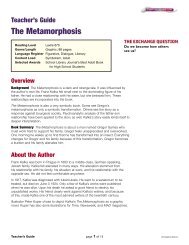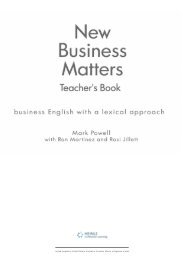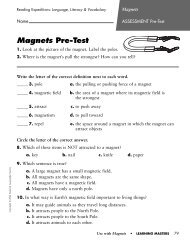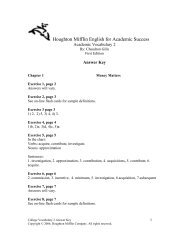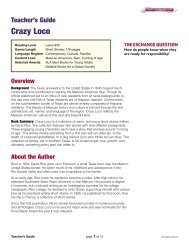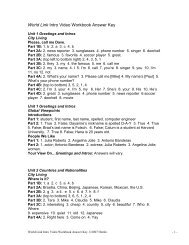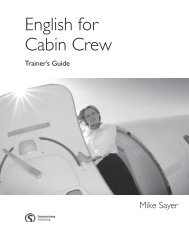Weaving It Together
Weaving It Together
Weaving It Together
You also want an ePaper? Increase the reach of your titles
YUMPU automatically turns print PDFs into web optimized ePapers that Google loves.
f. Use the teaching hints for additional<br />
ideas on using the reading and<br />
extending the comprehension<br />
activity.<br />
4. Discussion and critical thinking<br />
questions (15 minutes)<br />
The discussion and critical thinking<br />
questions give students a chance<br />
to respond to the readings on a<br />
personal level by relating the theme<br />
to their concerns and giving their<br />
own opinions. The result is a deeper<br />
processing of the material, which will<br />
help students remember the vocabulary<br />
and the theme and develop ideas to<br />
use in their writing later. You may ask<br />
students to summarize ideas from the<br />
discussions for homework.<br />
Reading 2 (90 minutes)<br />
1. Review (5 minutes)<br />
Review the vocabulary and themes<br />
from the previous reading. Extend<br />
the vocabulary to include words<br />
and phrases related to students’<br />
own cultural context, if appropriate.<br />
Encourage students to keep a<br />
systematic record of new vocabulary<br />
in a notebook or on cards, adding<br />
defi nitions and example sentences to<br />
help them remember. To provide an<br />
opportunity for peer teaching, match<br />
students with a partner and have them<br />
compare their vocabulary notes and<br />
suggest additional examples.<br />
2. Vocabulary and comprehension<br />
questions (15 minutes)<br />
Follow the same procedure as for<br />
Reading 1.<br />
10 Sample Lesson Plan<br />
3. Writing (20 minutes or<br />
homework, optional)<br />
This section emphasizes writing<br />
summaries, paraphrasing, and doing<br />
research. Familiarize students with the<br />
tips on summarizing and paraphrasing<br />
at the end of the book. This section is<br />
optional, but the research section may<br />
help students with writing their essays<br />
later in the chapter.<br />
4. Student essay, follow-up, and<br />
exercises (30 minutes)<br />
Use the student essay and follow-up<br />
questions to introduce the essay type<br />
for the chapter. This section gives<br />
students an overview of the essay type<br />
and provides language practice specifi c<br />
to this type of essay.<br />
5. Writing practice (20 minutes)<br />
Get students started on their essay<br />
by having them choose a title and<br />
brainstorm ideas. Those who work fast<br />
can start writing; those who need more<br />
time to develop ideas may discuss in<br />
pairs or groups.<br />
Lesson 3 (90 minutes)<br />
<strong>Weaving</strong> <strong>It</strong> <strong>Together</strong><br />
This page is composed of a Timed Writing<br />
activity, an Internet activity, and an<br />
opportunity to complete the What Do You<br />
Think Now? activity after having gathered<br />
the information from the readings. These<br />
activities provide an optional opportunity<br />
for further practice and offer students the<br />
chance to consolidate skills practiced in<br />
the unit.<br />
00238-X_006-073.indd 10 11/12/09 8:39 PM



